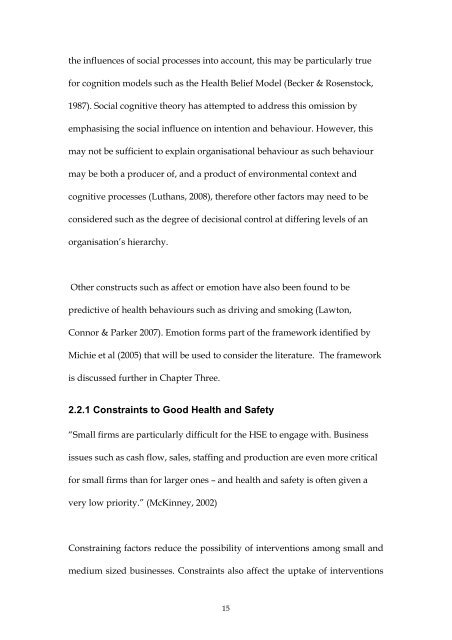PDF (A thesis submitted in partial fulfilment of the requirements for ...
PDF (A thesis submitted in partial fulfilment of the requirements for ...
PDF (A thesis submitted in partial fulfilment of the requirements for ...
You also want an ePaper? Increase the reach of your titles
YUMPU automatically turns print PDFs into web optimized ePapers that Google loves.
<strong>the</strong> <strong>in</strong>fluences <strong>of</strong> social processes <strong>in</strong>to account, this may be particularly true<br />
<strong>for</strong> cognition models such as <strong>the</strong> Health Belief Model (Becker & Rosenstock,<br />
1987). Social cognitive <strong>the</strong>ory has attempted to address this omission by<br />
emphasis<strong>in</strong>g <strong>the</strong> social <strong>in</strong>fluence on <strong>in</strong>tention and behaviour. However, this<br />
may not be sufficient to expla<strong>in</strong> organisational behaviour as such behaviour<br />
may be both a producer <strong>of</strong>, and a product <strong>of</strong> environmental context and<br />
cognitive processes (Luthans, 2008), <strong>the</strong>re<strong>for</strong>e o<strong>the</strong>r factors may need to be<br />
considered such as <strong>the</strong> degree <strong>of</strong> decisional control at differ<strong>in</strong>g levels <strong>of</strong> an<br />
organisation’s hierarchy.<br />
O<strong>the</strong>r constructs such as affect or emotion have also been found to be<br />
predictive <strong>of</strong> health behaviours such as driv<strong>in</strong>g and smok<strong>in</strong>g (Lawton,<br />
Connor & Parker 2007). Emotion <strong>for</strong>ms part <strong>of</strong> <strong>the</strong> framework identified by<br />
Michie et al (2005) that will be used to consider <strong>the</strong> literature. The framework<br />
is discussed fur<strong>the</strong>r <strong>in</strong> Chapter Three.<br />
2.2.1 Constra<strong>in</strong>ts to Good Health and Safety<br />
“Small firms are particularly difficult <strong>for</strong> <strong>the</strong> HSE to engage with. Bus<strong>in</strong>ess<br />
issues such as cash flow, sales, staff<strong>in</strong>g and production are even more critical<br />
<strong>for</strong> small firms than <strong>for</strong> larger ones – and health and safety is <strong>of</strong>ten given a<br />
very low priority.” (McK<strong>in</strong>ney, 2002)<br />
Constra<strong>in</strong><strong>in</strong>g factors reduce <strong>the</strong> possibility <strong>of</strong> <strong>in</strong>terventions among small and<br />
medium sized bus<strong>in</strong>esses. Constra<strong>in</strong>ts also affect <strong>the</strong> uptake <strong>of</strong> <strong>in</strong>terventions<br />
15




